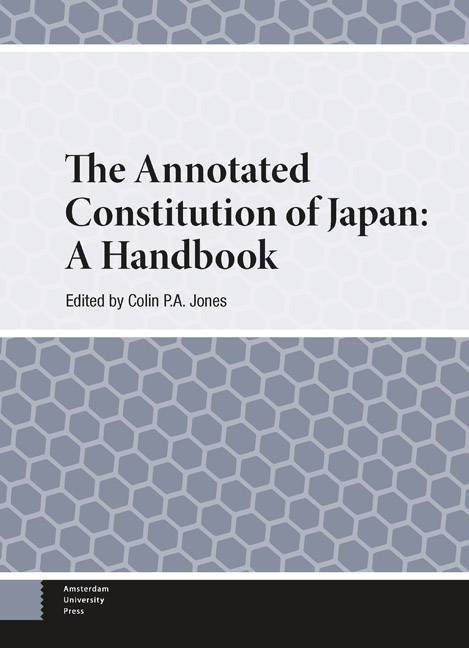Book contents
- Frontmatter
- Dedication
- Contents
- Contributors
- Preface
- Acknowledgements
- Introduction: Historical Overview
- The Preamble
- 1 Chapter I: The Emperor (Articles 1–8)
- 2 Chapter II: Renunciation of War (Article 9)
- 3 Chapter III: Rights and Duties of the People (Articles 10–40)
- 4 Chapter IV: The Diet (Articles 41–64)
- 5 Chapter V: The Cabinet (Articles 65–75)
- 6 Chapter VI: The Judiciary (Articles 76–82)
- 7 Chapter VII: Finance (Articles 83–91)
- 8 Chapter VIII: Local Self Government (Articles 92–95)
- 9 Chapter IX: Amendments (Article 96)
- 10 Chapter X: Supreme Law (Articles 97–99)
- 11 Chapter XI: Supplementary Provisions (Articles 100–103)
- Appendix 1 Constitution of the Empire of Japan (Japanese)
- Appendix 2 Constitution of the Empire of Japan (English translation)
- Appendix 3 The Potsdam Declaration
- Appendix 4 Instrument of Surrender
- Appendix 5 The “MacArthur Notes”
- Appendix 6 The GHQ Draft
- Appendix 7 The Constitution of Japan (Japanese)
- Appendix 8 The Treaty of San Francisco
- Bibliography
- Index
- Index of Articles of the Constitution of Japan
Introduction: Historical Overview
Published online by Cambridge University Press: 13 February 2024
- Frontmatter
- Dedication
- Contents
- Contributors
- Preface
- Acknowledgements
- Introduction: Historical Overview
- The Preamble
- 1 Chapter I: The Emperor (Articles 1–8)
- 2 Chapter II: Renunciation of War (Article 9)
- 3 Chapter III: Rights and Duties of the People (Articles 10–40)
- 4 Chapter IV: The Diet (Articles 41–64)
- 5 Chapter V: The Cabinet (Articles 65–75)
- 6 Chapter VI: The Judiciary (Articles 76–82)
- 7 Chapter VII: Finance (Articles 83–91)
- 8 Chapter VIII: Local Self Government (Articles 92–95)
- 9 Chapter IX: Amendments (Article 96)
- 10 Chapter X: Supreme Law (Articles 97–99)
- 11 Chapter XI: Supplementary Provisions (Articles 100–103)
- Appendix 1 Constitution of the Empire of Japan (Japanese)
- Appendix 2 Constitution of the Empire of Japan (English translation)
- Appendix 3 The Potsdam Declaration
- Appendix 4 Instrument of Surrender
- Appendix 5 The “MacArthur Notes”
- Appendix 6 The GHQ Draft
- Appendix 7 The Constitution of Japan (Japanese)
- Appendix 8 The Treaty of San Francisco
- Bibliography
- Index
- Index of Articles of the Constitution of Japan
Summary
Japan's present constitution is, obviously, a product of its history. An important facet of that history is the constitution which came before, the Constitution of the Empire of Japan, more commonly called the “Meiji Constitution,” after the Emperor Meiji who bestowed it on his subjects in 1889. A basic understanding of the historical background to both constitutions is thus important to understanding Japanese constitutional law today.
Since both charters are of comparatively modern provenance—at least when compared to the British or American constitutions—only a minimal inquiry into the history of Japan predating the Meiji Restoration of 1868 is necessary. There are numerous fine studies of the history of Japan after the Restoration by historians, so coverage of that period will also be brief. There are also several excellent accounts in English of the unusual circumstances of the constitution's birth during the postwar Occupation1 and at the time of writing all of the key documents could be accessed through the National Diet Library's “Birth of the Constitution of Japan” on-line exhibit. Thus, though a fascinating and dramatic story, only a brief outline of that part of the constitution's history will be provided in this work.
Prologue to Meiji: Ancient times through Tokugawa
Japan's legal system is comparatively modern. With the exception of emperors as a feature of government, virtually no Japanese laws or government institutions in existence today predates the Meiji Restoration of 1868, and most of those still in place can only be traced as far back as the birth of the Meiji Constitution or later.
The emperor system is a useful way of tracing the historical prelude to the Meiji Constitution. The first emperor, the probably mythical Emperor Jimmu, is said to have established the nation and acceded to the throne in 660 BC. According to the two earliest surviving historical narratives, the Kojiki (712) and Nihonshoki (721), Jimmu was a direct descendant of the deities that created the Japanese islands.
The supposedly unbroken lineage of emperors that followed Jimmu thus establishes a putative link between the imperial system and the divine origins of the Japanese nation. While this lineage no longer has formal political significance, it is relevant to the important role the emperor continues to play in the Shintō religion, including through forms of ancestor worship.
- Type
- Chapter
- Information
- The Annotated Constitution of JapanA Handbook, pp. 1 - 11Publisher: Amsterdam University PressPrint publication year: 2023



